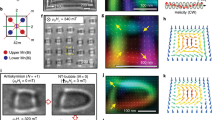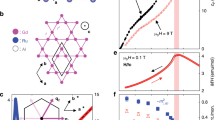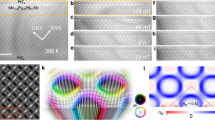Abstract
Chirality—that is, left- or right-handedness—is an important concept in a broad range of scientific areas. In condensed matter, chirality is found not only in molecular or crystal forms, but also in magnetic structures. A magnetic skyrmion1,2,3,4,5,6,7,8 is a topologically stable spin vortex structure, as observed in chiral-lattice helimagnets, and is one example of such a structure. The spin swirling direction (skyrmion helicity) should be closely related to the underlying lattice chirality via the relativistic spin–orbit coupling. Here, we report on the correlation between skyrmion helicity and crystal chirality in alloys of helimagnets Mn1−xFexGe with varying compositions by Lorentz transmission electron microscopy and convergent-beam electron diffraction over a broad range of compositions (x = 0.3–1.0). The skyrmion lattice constant shows non-monotonous variation with composition x, with a divergent behaviour around x = 0.8, where the correlation between magnetic helicity and crystal chirality changes sign. This originates from continuous variation of the spin–orbit coupling strength and its sign reversal in the metallic alloys as a function of x. Controllable spin–orbit coupling may offer a promising way to tune skyrmion size and helicity.
This is a preview of subscription content, access via your institution
Access options
Subscribe to this journal
Receive 12 print issues and online access
$259.00 per year
only $21.58 per issue
Buy this article
- Purchase on Springer Link
- Instant access to full article PDF
Prices may be subject to local taxes which are calculated during checkout




Similar content being viewed by others
References
Bogdanov, A. N. & Yablonskii, D. A. Thermodynamically stable ‘vortices’ in magnetically ordered crystals. The mixed state of magnets. Sov. Phys. JETP 68, 101–103 (1989).
Rößler, U. K., Bogdanov, A. N. & Pfleiderer, C. Spontaneous skyrmion ground states in magnetic metals. Nature 442, 797–801 (2006).
Binz, B., Vishwanath, A. & Aji, V. Theory of the helical spin crystal: a candidate for the partially ordered state of MnSi. Phys. Rev. Lett. 96, 207202 (2006).
Mühlbauer, S. et al. Skyrmion lattice in a chiral magnet. Science 323, 915–919 (2009).
Yu, X. Z. et al. Real-space observation of a two-dimensional skyrmion crystal. Nature 465, 901–904 (2010).
Yu, X. Z. et al. Near room-temperature formation of a skyrmion crystal in thin-films of the helimagnet FeGe. Nature Mater. 10, 106–109 (2011).
Tonomura, A. et al. Real-space observation of skyrmion lattice in helimagnet MnSi thin samples. Nano Lett. 12, 1673–1677 (2012).
Seki, S., Yu, X. Z., Ishiwata, S. & Tokura, Y. Observation of skyrmions in a multiferroic material. Science 336, 198–201 (2012).
Kanazawa, N. et al. Possible skyrmion-lattice ground state in the B20 chiral-lattice magnet MnGe as seen via small-angle neutron scattering. Phys. Rev. B 86, 134425 (2012).
Nagaosa, N., Yu, X. Z. & Tokura, Y. Gauge fields in real and momentum spaces in magnets: monopoles and skyrmions. Philos. Trans. A Math. Phys. Eng. Sci. 370, 5806–5819 (2012).
Fert, A., Cros, V. & Sampaio, J. Skyrmions on the track. Nature Nanotech. 8, 152–156 (2013).
Lee, M., Kang, W., Onose, Y., Tokura, Y. & Ong, N. P. Unusual Hall anomaly in MnSi under pressure. Phys. Rev. Lett. 102, 186601 (2009).
Neubauer, A. et al. Topological Hall effect in the A phase of MnSi. Phys. Rev. Lett. 102, 186602 (2009).
Kanazawa, N. et al. Large topological Hall effect in a short-period helimagnet MnGe. Phys. Rev. Lett. 106, 156603 (2011).
Schulz, T. et al. Emergent electrodynamics of skyrmions in a chiral magnet. Nature Phys. 8, 301–304 (2012).
Yu, X. Z. et al. Skyrmion flow near room temperature in an ultralow current density. Nature Commun. 3, 988 (2012).
Grigoriev, S. V. et al. Crystal handedness and spin helix chirality in Fe1−xCoxSi. Phys. Rev. Lett. 102, 037204 (2009).
Grigoriev, S. V. et al. Interplay between crystalline chirality and magnetic structure in Mn1−xFexSi. Phys. Rev. B 81, 012408 (2010).
Landau, L. D., Lifshitz, E. M. & Pitaevskii, L. P. in Electrodynamics of Continuous Media Vol. 8 (eds Lifshitz, E. M. & Pitaevskii, L. P.) 178–179 (Elsevier, 2008).
Uchida, M., Onose, Y., Matsui, Y. & Tokura, Y. Real-space observation of helical spin order. Science 311, 359–361 (2006).
Bajt, S. et al. Quantitative phase-sensitive imaging in a transmission electron microscope. Ultramicroscopy 83, 67–73 (2000).
Ishizuka, K. & Allman, B. Phase measurement of atomic resolution image using transport of intensity equation. J. Electron Microsc. 54, 191–197 (2005).
Tanaka, M., Takayoshi, H., Ishida, M. & Endoh, Y. Crystal chirality and helicity of the helical spin density wave in MnSi. I. Convergent-beam electron diffraction. J. Phys. Soc. Jpn 54, 2970–2974 (1985).
Tsuda, K. & Tanaka, M. Refinement of crystal structural parameters using two-dimensional energy-filtered CBED patterns. Acta Crystallogr. A 55, 939–954 (1999).
Ishida, M., Endoh, Y., Mitsuda, S., Ishikawa, Y. & Tanaka, M. Crystal chirality and helicity of the helical spin density wave in MnSi. II. Polarized neutron diffraction. J. Phys. Soc. Jpn 54, 2975–2982 (1985).
Morikawa, D., Shibata, K., Kanazawa, N., Yu, X. Z. & Tokura, Y. Crystal chirality and skyrmion helicity in MnSi and (Fe, Co)Si as determined by transmission electron microscopy. Phys. Rev. B 88, 024408 (2013).
Grigoriev, S. V. et al. Chiral properties of structure and magnetism in Mn1−xFexGe compounds: when the left and the right are fighting, who wins? Phys. Rev. Lett. 110, 207201 (2013).
Lebech, B., Bernhard, J. & Freltoft, T. Magnetic structures of cubic FeGe studied by small-angle neutron scattering. J. Phys. Condens. Matter 1, 6105–6122 (1989).
Acknowledgements
The authors thank N. Nagaosa, S. Seki, T. Kurumaji and Y. Okamura for helpful discussions. This study was supported by a Grant-in-Aid for Scientific Research (grant no. 24224009) from MEXT, and by the Funding Program for World-Leading Innovative R&D on Science and Technology (FIRST Program).
Author information
Authors and Affiliations
Contributions
K.S. synthesized the polycrystalline samples, prepared the TEM samples, carried out the Lorentz TEM observations, and applied the CBED method. X.Z.Y. measured the EELS thickness map. T.H. measured the EDX composition map. D.M. analysed the CBED patterns. N.K. and S.I. contributed to the synthesis of polycrystalline samples. K.K. and Y.M. contributed to the EELS and EDX studies. Y.T. conceived the project and wrote the manuscript with K.S. and N.K.
Corresponding authors
Ethics declarations
Competing interests
The authors declare no competing financial interests.
Supplementary information
Supplementary information
Supplementary Information (PDF 1227 kb)
Rights and permissions
About this article
Cite this article
Shibata, K., Yu, X., Hara, T. et al. Towards control of the size and helicity of skyrmions in helimagnetic alloys by spin–orbit coupling. Nature Nanotech 8, 723–728 (2013). https://doi.org/10.1038/nnano.2013.174
Received:
Accepted:
Published:
Issue Date:
DOI: https://doi.org/10.1038/nnano.2013.174
This article is cited by
-
Exploring the Magnetic Behavior of a Magnetic High-Entropy Alloy with Dual-Phase B20 Crystal Structure
Journal of Superconductivity and Novel Magnetism (2023)
-
First-principles calculations for Dzyaloshinskii–Moriya interaction
Nature Reviews Physics (2022)
-
Magnetic chirality
npj Quantum Materials (2022)
-
Electric field manipulation of magnetic skyrmions
Rare Metals (2022)
-
Generation and manipulation of skyrmions and other topological spin structures with rare metals
Rare Metals (2022)



